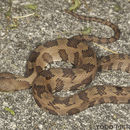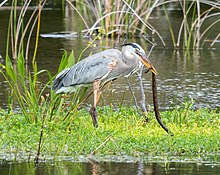fi
nimet breadcrumb-navigoinnissa


Nerodia taxispilota is fairly abundant (so much so that in favorable habitats, 12 or more can be seen in the same area in a small amount of time).
US Federal List: no special status
CITES: no special status
IUCN Red List of Threatened Species: least concern
Nerodia taxispilota has no economic importance (positive or negative) for humans.
Nerodia taxispilota has no economic importance (positive or negative) for humans.
Nerodia taxispilota is piscivorous, preying primarily benthic-feeding fish (mostly minnows, some juvenile catfish), and on frogs. Fetal brown water snakes are nourished by fat yolks deposited within their membranous egg shrouds. Thus female Nerodia taxispilota must acquire lipid reserves well in advance of pregnancies. Gravid females are limited in their hunting strategies (because of their weight) and may rely on scavenging.
Brown water snakes are found in southeastern North America, along the Coastal Plain from Virginia south through the lowlands of the Carolinas, most of Georgia, all of Florida and southern Alabama.
Biogeographic Regions: nearctic (Native )
Nerodia taxispilota is most common in and around clear, quiet waters, on fallen trees, or even bushes suitable for basking. The species has been collected in lakes, rivers, streams, cypress swamps and waterways, canals, drainage ditches, and ponds, especially where overhanging vegetation is present. It is also common around hardwood hammocks of wet materials, sawgrass prairies, bottomland forests, and near tree-bordered margins of brackish tidal marshes.
Terrestrial Biomes: forest
Aquatic Biomes: lakes and ponds; rivers and streams
Average lifespan
Status: captivity: 6.1 years.
Nerodia taxispilota ranges in length from 28 to 69 inches (71.1cm-175.3 cm). The record length is 69.5" (176.6 cm). Females are larger; males do not reach the size of the largest females. Brown Water Snakes are relatively heavy-bodied, and have a large head distinctly wider than the neck. This produces a heart- or diamond-headed appearance (if viewed from above) that makes this species easy to confuse with venomous snakes in the Viperidae family (such as cottonmouths (Agkistrodon piscivorous) and rattlesnakes. Nerodia taxispilota is brown to dark brown in color (indicated by its common name). The most distinctive mark is the separation between its large brown (usually light-edged), squarish vertebral blotches that occur along the lengths of its body. These blotches alternate with a row of similar blotches on each side of the body. Many specimens are exceptionally dark, being a deep chocolate brown in gross appearance and with blotches only a little darker than ground color. The belly of -N. taxispilota- is yellow to brown and boldly marked with brown splotches and black crescents. These markings are often arranged in broken rows along its sides. The dorsal scales of Nerodia taxispilota are strongly keeled in 25-33 midbody rows, and its anal plate is divided. The tail tapers abruptly, and its eyes are high and set forward towards the nose.
This species breeds between late February and early May, with neonates appearing between June and October. Snakes don't have set gestation periods because pregnancy is initiated by the females' ovulation, not by deposition of semen. Viable sperm may be stored for months or even years within the cloaca of inseminated but not-yet-fertilized females. Female Nerodia taxispilota must increase their body's store of lipids by some 50% in order to become pregnant. They give live birth to as many as 60 offspring at once. These offspring range from 7 to 11 inches in length, and their coloring is much brighter than that of their parents.
Die Braune Schwimmnatter (Nerodia taxispilota) wird auch Braune Wassernatter oder Braune Wasserschlange genannt. Sie ist in den südöstlichen USA von Virginia bis Alabama verbreitet und kommt dort an Fluss- und Seeufern sowie in Sümpfen vor.
Mit einer Länge von 120 bis 170 cm ist N. taxispilota eine große gedrungene Wassernatter, die auf hell- bis dunkelbraunem Grund drei Reihen mehr oder weniger quadratischer, versetzt angeordneter Flecken trägt. Die Bauchseite ist gelb mit auffälliger Fleckung.
Braune Schwimmnattern sind tagaktiv und ernähren sich hauptsächlich von Fischen und Fröschen. Sie können ausgezeichnet klettern und sonnen sich häufig auf über der Wasserfläche hängenden Zweigen. Die Paarung erfolgt im April oder Mai, und im Sommer werden bis zu 50 Junge zur Welt gebracht, die schon eine Länge von 50 cm erreichen.
Diese Natter ist eine wehrhafte Art, die sich nicht nur durch das Entleeren übelriechenden Analsekrets, sondern auch durch heftige und schmerzhafte Bisse verteidigt.
Die Braune Schwimmnatter (Nerodia taxispilota) wird auch Braune Wassernatter oder Braune Wasserschlange genannt. Sie ist in den südöstlichen USA von Virginia bis Alabama verbreitet und kommt dort an Fluss- und Seeufern sowie in Sümpfen vor.
The brown water snake (Nerodia taxispilota) is a large species of nonvenomous natricine snake endemic to the southeastern United States. This snake is often one of the most abundant species of snakes found in rivers and streams of the southeastern United States, yet many aspects of its natural history is poorly known. Due to abundance and distribution throughout its biological range, this species could be used to investigate anthropogenic impacts on aquatic ecosystems by studying their movements.[2]
Lycodonomorphus rufulus is sometimes also called the brown water snake, but L. rufulus is found in South Africa.
Its common names include brown water snake, water-pilot,[3] aspic, false moccasin, great water snake, pied water snake, southern water snake, and water rattle.[4]
N. taxispilota is found in lower coastal regions from southeastern Virginia, through North Carolina, South Carolina, and Georgia, to northern and western Florida (Gulf Coast), then west through Missouri, Alabama, and Mississippi, to Louisiana, normally from sea level to 500 ft. (150 m) elevation.[4]
The brown water snake is very heavy-bodied, and its neck is distinctly narrower than its head. Dorsally, it is brown or rusty brown with a row of about 25 black or dark brown, square blotches down its back. Smaller similar blotches alternate on the sides. Ventrally, it is yellow, heavily marked with black or dark brown.[5] Dorsal scales are in 27-33 rows (more than any other North American water snake), and it has two to four anterior temporals (usually one in others).[6] Adults measure 30–60 in. (76–152 cm) in total length; record 69 in. (175 cm).[7]
N. taxispilota is found in swamps and streams and is often mistaken for a moccasin. N. taxispilota are widely distributed in the coastal and piedmont regions of the Southeastern United States. More commonly found in flowing water such as rivers, canals, and black water cypress creeks N. taxispilota can also be found in large water reservoirs and lakes. Their preference of a pescatarian diet keeps them from living in ephemeral wetlands.

N. taxispilota is ovoviviparous. Mating takes place in the spring on land or on tree branches. On average, adult females are larger than adult males. The young are born alive, usually in August, in broods of 14–58, more commonly 30–40. The newborns are 7-10¾ in (18–27 cm) long, with males longer than females, opposite of adults.[4]
Mark S. Mills, Chris J. Hudson, & Berna, H. J. (1995). Spatial Ecology and Movements of the Brown Water Snake (Nerodia taxispilota). Herpetologica, 51(4), 412–423. http://www.jstor.org/stable/3892767
The brown water snake (Nerodia taxispilota) is a large species of nonvenomous natricine snake endemic to the southeastern United States. This snake is often one of the most abundant species of snakes found in rivers and streams of the southeastern United States, yet many aspects of its natural history is poorly known. Due to abundance and distribution throughout its biological range, this species could be used to investigate anthropogenic impacts on aquatic ecosystems by studying their movements.
Lycodonomorphus rufulus is sometimes also called the brown water snake, but L. rufulus is found in South Africa.
Nerodia taxispilota Nerodia generoko animalia da. Narrastien barruko Natricidae familian sailkatuta dago.
Nerodia taxispilota Nerodia generoko animalia da. Narrastien barruko Natricidae familian sailkatuta dago.
Nerodia taxispilota est une espèce de serpents de la famille des Natricidae[1].
Cette espèce est endémique des États-Unis. Elle se rencontre en Caroline du Sud, dans l'est de la Caroline du Nord, en Floride, dans le sud-est de l'Alabama, dans l'ouest de la Virginie et en Géorgie[1].
Nerodia taxispilota est une espèce de serpents de la famille des Natricidae.
Nerodia taxispilota là một loài rắn trong họ Rắn nước. Loài này được Holbrook mô tả khoa học đầu tiên năm 1838.[1]
Nerodia taxispilota là một loài rắn trong họ Rắn nước. Loài này được Holbrook mô tả khoa học đầu tiên năm 1838.